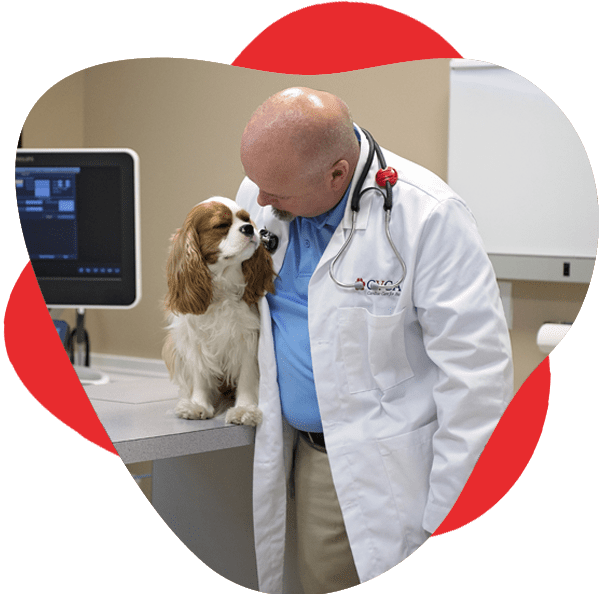What You Need to Know Concerning Vet Providers: An Introduction of Diagnostic Devices and Procedures
Veterinary services play an essential duty in preserving the wellness of family pets. Routine exams can disclose hidden health and wellness concerns early. Different analysis tools and procedures, such as blood tests and imaging methods, supply crucial understandings right into an animal's well-being. Comprehending these techniques is essential for pet owners. What specific analysis treatments are most typically used, and exactly how can they influence an animal's therapy strategy?
Importance of Routine Veterinary Exams
While many pet proprietors may take too lightly the relevance of routine veterinary exams, these visits are necessary for keeping a pet's overall health. Regular brows through to the veterinarian enable early detection of possible health issues before they escalate into severe troubles. Routine check-ups commonly consist of inoculations, which are very important for avoiding infectious diseases that might significantly affect a family pet's health. Additionally, these appointments supply an opportunity for vets to examine the animal's weight, oral health and wellness, and general problem, guaranteeing that the pet dog is prospering. Throughout these gos to, family pet owners can also get important recommendations on diet, workout, and preventive care customized to their certain pet's demands.
Common Analysis Procedures in Veterinary Medication
In veterinary medicine, exact medical diagnosis is important for efficient therapy. Typical diagnostic procedures consist of blood screening techniques, progressed imaging innovations, and urinalysis, each playing a substantial duty in determining wellness problems. Recognizing these methods improves the capacity to provide appropriate look after animal people.
Blood Examining Methods
Blood screening methods act as crucial analysis devices in veterinary medicine, allowing veterinarians to analyze the wellness of pets precisely. These strategies include accumulating blood samples to assess numerous elements, such as red and white blood cells, platelets, and biochemical pens. Common tests consist of complete blood counts (CBC), which review overall health and spot infections, and biochemical panels, which assess body organ function and metabolic condition. Furthermore, serological tests can determine specific illness with antibody detection. Blood screening is minimally intrusive and supplies essential info that aids in identifying conditions, checking wellness standing, and assessing actions to treatments. In general, these strategies play a crucial duty in making sure ideal look after pets and animals alike.
Imaging Technologies Made Use Of
Diagnostic imaging technologies are crucial tools in vet medicine, complementing blood screening methods by giving aesthetic understandings into an animal's inner frameworks. Common imaging modalities consist of X-rays, which serve for assessing bone fractures and finding foreign items, and ultrasound, which permits real-time visualization of soft cells and organs. Magnetic resonance imaging (MRI) uses in-depth pictures of complicated physiological areas, especially in neurological evaluations. Calculated tomography (CT) offers cross-sectional pictures, enhancing analysis accuracy for various problems. Each of these modern technologies help veterinarians in identifying illnesses, intending treatments, and monitoring recovery. By incorporating imaging innovations, veterinary experts can better analyze an animal's wellness and make educated choices concerning their treatment.
Urinalysis and Diagnostics
Urinalysis offers as an important diagnostic device in vet medication, supplying useful understandings into an animal's total wellness and assisting in the detection of various conditions. This non-invasive treatment evaluates pee samples to analyze kidney feature, hydration status, and metabolic disorders. Common parts analyzed include details gravity, pH degrees, sugar, healthy proteins, and the presence of blood or germs. Uncommon searchings for can indicate concerns such as urinary system tract infections, diabetic issues mellitus, or kidney illness. To boost analysis accuracy, urinalysis is typically done together with various other tests, such as blood work and imaging studies. Early detection with urinalysis can bring about prompt interventions, boosting the prognosis for numerous veterinary individuals. It is an important aspect of detailed veterinary care.
Comprehending Blood Tests and Lab Evaluation
Recognizing blood examinations and laboratory evaluation is vital in veterinary medication as it aids in diagnosing numerous wellness problems in animals. Various sorts of blood tests supply necessary info concerning an animal's interior state, while analyzing laboratory results requires careful factor to consider of numerous elements. This section will explore the kinds of blood examinations available and the value of their outcomes.
Kinds Of Blood Examinations
Blood examinations play an essential role in veterinary medicine, supplying crucial insights right into an animal's health and wellness condition. Different sorts of blood examinations are made use of, each offering various functions. Complete blood matters (CBC) assess total health and wellness and spot conditions such as anemia or infection. Biochemical profiles evaluate body organ feature by determining electrolytes and enzymes, using understandings into metabolic wellness. Serological examinations identify particular antibodies or microorganisms, helping in the diagnosis of infections or autoimmune diseases. Blood keying warranties safe transfusions, while coagulation examinations evaluate the blood's ability to clot, essential for surgeries. These examinations collectively enhance medical diagnosis, therapy planning, and monitoring of an animal's health and wellness, showing the value of comprehensive lab evaluation in vet care.

Interpreting Lab Results
A detailed analysis of laboratory outcomes is essential for precise diagnosis and therapy in vet medicine. Analyzing lab results calls for an understanding of normal recommendation arrays and the relevance of variances. Blood tests can reveal various wellness signs, such as body organ feature, electrolyte equilibrium, and the presence of infections. Veterinarians need to think about the whole medical picture, including the pet's history, physical exam findings, and any kind of signs and symptoms offered. Variations in results may develop from elements such as age, breed, and underlying health and wellness conditions. Consequently, laboratory results should not be viewed alone however rather as part of an all-inclusive diagnostic strategy. Accurate interpretation permits customized treatment plans and better end results for vet clients.
Imaging Techniques: X-rays, Ultrasounds, and Beyond
Imaging methods are necessary devices in vet medication, giving crucial insights into the wellness and well-being of animals. Among the most generally used methods are Ultrasounds and x-rays. X-rays are vital for picturing bone frameworks, helping veterinarians determine cracks, tumors, or international items. This approach is fast and non-invasive, making it suitable for immediate situations.Ultrasounds, on the other hand, use acoustic waves to develop photos of soft cells and organs. This strategy is especially valuable for analyzing the heart, abdomen, and reproductive organs, allowing veterinarians to evaluate problems like fluid accumulation or organ abnormalities.Beyond X-rays and ultrasounds, progressed imaging strategies such as computed tomography (CT) and magnetic vibration imaging (MRI) are increasingly made use of in veterinary technique. These More Help methods use detailed cross-sectional pictures, improving the precision of diagnoses and treatment plans. Board Certified Veterinary Cardiologist. Overall, imaging strategies play a necessary function in making certain efficient veterinary treatment
The Duty of Biopsies in Diagnosing Animal Wellness Issues
Accuracy in diagnosing health and wellness problems in pets often rests on the use of biopsies, which offer clear-cut information concerning cells abnormalities. A biopsy entails the removal of a small example of tissue for exam under a microscopic lense, allowing vets to determine numerous problems, including infections, growths, and inflammatory diseases. This diagnostic tool is necessary for comparing benign and deadly developments, leading treatment decisions, and reviewing the extent of a condition.Biopsies can be executed using various techniques, such as needle goal, incisional biopsies, or excisional biopsies, depending on the area and kind of tissue involved. The selection of approach may impact healing time and the quantity of tissue accumulated. Inevitably, the info obtained from a biopsy can lead to targeted treatments, boosting results for animals encountering serious health obstacles. Veterinarians emphasize the significance of this procedure in accomplishing exact diagnoses and reliable treatment plans.
Advanced Diagnostic Equipment: Endoscopy and CT Scans

Advanced analysis tools, such as endoscopy and CT scans, play an essential function in modern veterinary medication, providing non-invasive approaches to visualize inner frameworks and identify various conditions in animals. Endoscopy involves the use of a versatile tube geared up with a camera, permitting vets to examine the stomach system and respiratory system directly. This strategy can reveal irregularities such as lumps, foreign bodies, or swelling, allowing targeted treatment plans.CT scans, on the other hand, use innovative imaging technology to create thorough cross-sectional photos of the body (Cancer Veterinary Near Me). This approach is specifically useful for evaluating complex frameworks like the mind, spine, and joints. By providing high-resolution photos, CT scans aid veterinarians in recognizing concerns that may not be obvious through typical radiography. With each other, these sophisticated tools improve diagnostic accuracy, boost treatment results, and inevitably add to much better total pet dog health administration

Interpreting Examination Outcomes: What Pet Owners Should Know
Recognizing test outcomes can be a challenging task for animal proprietors, particularly after advanced procedures like endoscopy and CT scans have been done. Interpreting these outcomes needs an understanding of clinical terms and a clear understanding of what the findings show concerning the animal's health and wellness. Veterinarians usually offer explanations, however the intricacy of the outcomes can still result in confusion.Pet proprietors should proactively participate in discussions with their vets, asking concerns to clarify any type of uncertainties. It is vital to recognize regular versus uncommon results and the ramifications for the pet dog's therapy strategy. Furthermore, identifying that some outcomes might require more screening or monitoring can help proprietors stay notified about their pet dog's health and wellness trip. Eventually, a collaborative strategy between pet proprietors and veterinary professionals promotes better health and wellness end results and enhances the general treatment experience for pets.
Often Asked Inquiries
How Do I Choose the Right Veterinary Clinic for My Pet?
Selecting the appropriate vet center entails looking into regional alternatives, evaluating qualifications, visiting centers, and examining team communications (Ultrasound For Dogs). Focusing on suggestions from trusted sources can aid ensure the very best treatment and environment for a pet dog's wellness demands
What Should I Do if My Pet Dog Rejects to Go to the Vet?
When a pet declines to go to the veterinarian, it's suggested to stay calm, usage treats or toys to lure them, and think about scheduling a home see if anxiousness continues. Patience and favorable support are essential.
Exist Telehealth Options for Veterinary Providers?
Telehealth options for veterinary services are increasingly available, enabling website here pet dog owners to seek advice from veterinarians remotely. These solutions make it possible for discussions regarding wellness issues, suggestions on minor conditions, and follow-ups without requiring to visit a clinic.
Exactly how Typically Should My Animal Have Oral Exams?
The regularity of dental examinations for pets normally depends upon their age and breed. Normally, veterinarians recommend annual oral assessments, although some family pets might need even more constant check outs to maintain optimal oral health and wellness.

What Are the Prices Associated With Veterinary Diagnostics?
The expenses connected with vet diagnostics can differ widely, typically varying from basic examinations like blood job to advanced imaging methods. Factors affecting expenses include the clinic's location, devices utilized, and specific tests required for each and every pet. Veterinary solutions play an essential role in preserving the health of pets. While numerous More Help family pet proprietors might underestimate the significance of regular vet exams, these consultations are essential for maintaining a pet's total wellness. In addition, these consultations give a possibility for vets to examine the animal's weight, dental health, and total problem, making sure that the family pet is prospering. Precision in diagnosing health concerns in animals commonly pivots on the use of biopsies, which supply conclusive information about cells irregularities. Furthermore, recognizing that some outcomes might call for more testing or tracking can aid owners stay informed concerning their pet dog's health trip.